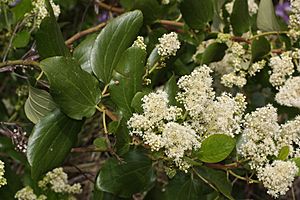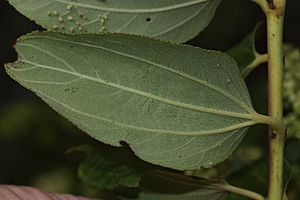Ceanothus velutinus facts for kids
Quick facts for kids Ceanothus velutinus |
|
|---|---|
 |
|
| Scientific classification | |
| Genus: |
Ceanothus
|
| Species: |
velutinus
|
Ceanothus velutinus, often called snowbrush ceanothus, red root, or tobacco brush, is a type of shrub. It belongs to the plant family called Rhamnaceae. This plant is native to western North America. You can find it from British Columbia in Canada, all the way down to California, and east to Colorado. It grows in many different places, like pine forests, chaparral (a type of shrubland), and various kinds of woodlands.
Contents
Description
Ceanothus velutinus can grow up to 4 meters (about 13 feet) tall. However, it usually stays under three meters (10 feet). It often grows in groups, forming thick, tangled bushes. These thickets can be quite difficult to walk through.
Leaves and Flowers
The leaves of this plant are evergreen, meaning they stay green all year. They also have a pleasant smell. Each leaf is arranged one after another on the stem. They can be up to 8 centimeters (about 3 inches) long. The leaves are oval-shaped. They have tiny, special teeth along their edges. The top surface of the leaves is shiny green and smooth.
The plant produces many white flowers. These flowers grow in long clusters.
Seeds and Growth
After flowering, the plant forms a fruit. This fruit is a small, three-part capsule. It is only a few millimeters long. When the fruit is ready, it snaps open very quickly. This action shoots the three seeds out onto the soil.
These seeds can stay buried in the ground for a very long time. They can wait for over 200 years before they start to grow. The seed has a very hard outer layer. This layer must be broken open before the seed can sprout. This usually happens during a wildfire. The heat from the fire helps to crack the hard seed coat.
Like most other ceanothus plants, this species is special. It can add nitrogen to the soil. It does this with the help of tiny living things called actinomycetes. These tiny helpers live on the plant's roots.
Uses
Wildlife Food
Deer and elk often eat this plant. They especially like to browse on it during the winter months.
Traditional Uses
Some Native American tribes used Ceanothus velutinus. They would make a tea from the plant. This tea was used to help people sweat. It was a traditional treatment for colds, fevers, and influenza (the flu). The leaves were also used when rinsing hair. This was thought to help prevent dandruff.
Many Native American tribes called Ceanothus velutinus "red root." This name came from the color of the inner bark of its roots. The root was used as a medicine for various health issues. It was used to help with problems related to the body's cleaning system (lymphatic system). It was also used for other specific health concerns.
Modern Discoveries
Scientists have studied the compounds found in C. velutinus. These studies have shown that some parts of the plant can help with high blood pressure. They can also help with blockages in the lymphatic system.


